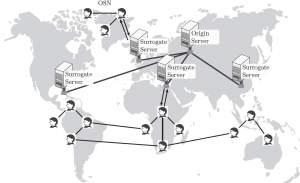Case Study Team
Coordinators
| Id | Name | Institution (type*) | Related WG | Role in the team |
1 |
George Angelos Papadopoulos | University of Cyprus, CY (A) | WG1, WG2 | Coordinator |
2 |
Irene Kilanioti | University of Cyprus, CY (A) | WG1 | Vice-Coordinator |
Team members
| Id | Name | Institution (type*) | Related WG |
| 1 | Rabih Bashroush | University of East London, UK (A) | WG1 |
| 2 | Luis Correia | University of Lisbon, PT (A) | WG2 |
| 3 | Nikolas Almpanis | WG1 | |
| 4 | Dave Feenan | Technology Ireland Innovation Forum, IE (I) | WG1 |
| 5 | Alejandro Fernandez-Montes | University of Seville, ES (A) | WG1 |
| 6 | Anthony Karageorgos | Technological Educationl Institute of Thessaly, GR (A) | WG1, WG2 |
| 7 | Elli Rapti | University of Thessaly, GR (A) | WG1 |
| 8 | George Suciu | BEIA Consult International Romania, RO (I) | WG1 |
| 9 | Damián Fernández Cerero |
WG1 | |
| 10 | Mateusz Nytko | WG1 | |
| 11 | Adrian Widłak | WG1 | |
| 12 | Nikolas Almpanis | WG1 |
*A-academia, I-industry
Addressed Problem
The improvement of user experience through scaling bandwidth-demanding content largely depends on the exploitation of usage patterns found in OSNs. Big data analysis tasks (such as cascades characterization) accommodate large volumes of data for the improvement of user experience, e.g. via prefetching in the framework of a CDN infrastructure that streaming providers own. Usage patterns information can be applied in situations where traditional bandwidth-intensive content scaling is infeasible: global replication demanded by traditional CDNs for the voluminous content produced becomes expensive and, moreover, user-generated content is especially difficult due to its long tail nature, with each item probably not popular enough to be replicated globally, but with the long-tail altogether getting sufficient accesses.
We aim at the most efficient placement of surrogate servers, best content diffusion placement, and efficient temporal content diffusion, taking into account challenges associated with content delivery datacenters: energy awareness and efficiency for consumption on data centers, high performance maintenance and load balancing, resilience, optimization of data / system redundancy, time critical issues like self-adaptation and data localization, optimal route selection within 5G networks, and workload optimization considering implications on the infrastructure and the whole system.
Existing Solution(-s) (Models, Tools)
-
Network approaches (Content Centric Networking for content delivery optimization)
-
Optimization of data centers (Holistic approach)
-
In-memory keeping, systems for social network content delivery (e.g. Buzztraq/ Tailgate)
-
SWITCH Project (Software Workbench for Interactive, Time-Critical and Highly self-adaptive cloud applications)
Proposed Solution(-s) (Models, Tools)
Prototype (pull-based approach heuristics) presented in cHiPSet publications (see below Supplementary Material)
-
List of implemented applications: Social Prefetcher, Variations: V-Efficient Timing, V-Caching Schemes, V-Predictive Model, V-Popular Items
-
List of used tools and libraries: OMNET++,Bison, g++, boost libraries, Python
-
List of used programming languages: Python, C++
We aim at the design of a framework that incorporates:
-
Design of an holistic approach combining application- and infrastructure-level decisions
-
Applications of heuristics to facilitate precise and seamless prefetching decisions
-
Use of a realistic industrial application as a testbed for the developed framework
Practical Scenarios (-s)
A social network user with most of his/her social contacts geographically close to
him/her logs into the Online Social Network (OSN) and uploads a video that he/she wants to
share. A naive way to ensure that this content is as close as possible to all users before any
accesses occur would be to push the content to all other geographically distributed servers
immediately.
Aggregated over all users, pushing can lead to a traffic spike, and users will experience
latency in downloading the content. Indeed, content delivery is subject to delay jitter and clients
are required to preload a playout buffer before staring the video playback. Moreover, the content
may not be consumed at all. The problem of caching multimedia content is further exacerbated
when unique friends of the user in an area are interested in that content.
Rather than pushing data to all surrogates, we can proactively distribute it only to friends
likely to consume it. The content will be copied only under certain conditions (e.g.
geographically close user zones where the user has mutual friends with high centrality, at non-
peak times for the transfer according to the friend’s zone), and users would not experience
unnecessary delays in downloading the content. Thus, users would not have to wait for the
content to be downloaded, and the OSN provider would experience lower bandwidth costs, as
traffic congestion would be avoided. With the use of evolving graph sequence analysis, this
approach can be applicable as an in-house solution of OSN providers. The necessary data will
not have to be calculated on the fly, but only across snapshots of gradually evolving graphs,
reducing bandwidth and storage costs.
Moreover we are interested in addressing challenges associated with the OSN
datacenters: energy efficiency for consumption on data centers, high performance maintenance
and load balancing, resilience, optimization of data / system redundancy, time critical issues like
self-adaptation and data localization, optimal route selection and workload optimization within
5G networks, etc.
Supplementary Material
Case Study Presentation pdf
Publications (in the framework of cHiPSet):
- I. Kilanioti and G.A. Papadopoulos, Content Delivery Simulations supported by Social
Network awareness, Simulation Modelling Practice and Theory Journal – SIMPAT
Elsevier, Volume 71, February 2017, Pages 114-133, Elsevier. pdf - I. Kilanioti and G. A. Papadopoulos, Delivering social multimedia content with scalability, in
Resource Management for Big Data Platforms: Algorithms, Modelling and High Performance
Computing Techniques, Springer Computer Communications and Networks Series, Eds. J.
Kolodziej, Florin Pop and B. di Martino, Springer, 2016, ch. 18. pdf - I. Kilanioti and G. A. Papadopoulos, Predicting video virality on Twitter, in Resource
Management for Big Data Platforms: Algorithms, Modelling and High-Performance Computing
Techniques, Springer Computer Communications and Networks Series, Eds. J. Kolodziej, Florin
Pop and B. di Martino, Springer, 2016, ch. 20. pdf -
I. Kilanioti, A. Fernández-Montes, D. Fernández-Cerero, C. Mettouris, V. Nejkovic, R. Bashroush, G. A. Papadopoulos, A Survey on Cost-effective Context-aware Distribution of Social Data Streams over Energy-efficient Data Centers, ELSEVIER SIMPAT Special Issue on Modeling and Simulation of Cloud Computing and Big Data, In press, DOI: 10.1016/j.simpat.2018.11.004.
- 5.I. Kilanioti and G. A. Papadopoulos, Predicting video virality on Twitter, inResource Management for Big Data Platforms: Algorithms, Modelling and High-
Performance Computing Techniques, Springer Computer Communications and NetworksSeries, Eds. J. Kolodziej, Florin Pop and B. di Martino, Springer, 2016, ch. 20.

